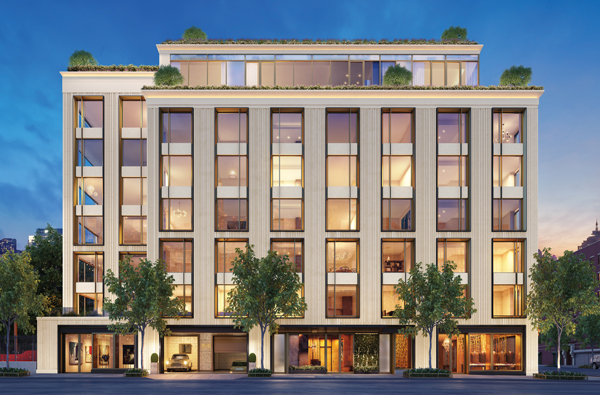Trending
75 Kenmare: An elegant outsider
The Andre Kikoski-design condo, which features interiors by Lenny Kravitz, brings a subtle gracefulness to the less-than elegant LES strip

Kenmare Street, on Manhattan’s Lower East Side, is becoming one of the most architecturally interesting corridors in the five boroughs. Its first significant development dates back to 2006, when the developer Andre Balazs’ curvy glass condo One Kenmare Square debuted. Since then, the short street that is Kenmare has become a magnet for trendy restaurants and boutiques.
And today, Tadao Ando, a Pritzker Prize winner, has 152 Elizabeth Street nearing completion at a corner on the stretch. To these heterogeneous structures will soon be added a very different sort of building: 75 Kenmare, a cream-colored seven-story structure conceived in almost classical early modernism.
Developer DHA Capital tapped the young firm of Andre Kikoski Architect to design the 38-unit condo building, while Grammy-winning musician Lenny Kravitz’s Kravitz Design is handling the interiors.
For now, the 75 Kenmare site, which previously housed a three-story garage, still appears to be empty, although the lot has been excavated and the foundations are being laid. Upon completion in 2018, the project will contain 47,000 square feet of residential space, 8,100 of commercial space and 150 underground parking spaces. Prices on the condos, which launched sales in February, will range from $1.7 million to $12 million, according to DHA.
Often, when architects build in Manhattan, they reflexively claim that their structure fits in with its architectural surroundings. While the same is true here, I must say that I do not quite see the contextualism. The masonry of the concrete façade has a certain prewar feel to it, but it looks unlike any building in the neighborhood.
In part, Kikoski was challenged by a ruling from the Department of Buildings requiring all new developments in the Nolita-Little Italy Historic District to use masonry — which in this case seems to mean anything other than modernist glass curtain walls, whether it be brick, granite or, in the present case, concrete panels — in at least 50.01 percent of their façades. The structure feels incongruously European in the context of the Lower East Side. That said, it is still an extremely subtle and elegant piece of work
And it speaks to the changing nature of Kenmare, which since has become home to upscale residences.

Andre Kikoski
The planned condo is a rare example of a freestanding building designed by Kikoski in the five boroughs. In fact, he has concentrated almost exclusively on interior design, although of a decidedly architectural nature. An excellent example can be seen at the Wright, the upscale restaurant in the Guggenheim Museum that opened in 2010 and received the James Beard Foundation Award winner for Outstanding Restaurant Design later that year. Its swerving, chromatic dazzle matches the energy implicit in Frank Lloyd Wright’s original building, but, almost miraculously, brings it off with great competence and skill. Kikoski also designed the very ingenious Suba, an atmospheric restaurant on the Lower East Side that recently closed, as well as the stunning Wyckoff Exchange, a 10,000-square-foot abandoned warehouse in Brooklyn’s Bushwick that he transformed with an elaborate façade of movable, rust-colored corten steel awnings. And now, his firm is now working on the interiors of one of Related Companies’ luxury condo towers at Hudson Yards.
One of the few ground-up projects he has designed is the Z Hotel in Long Island City, which looks out at Manhattan from just across the East River.
There are similarities between that building and 75 Kenmare Street: Both are strictly rectilinear and almost classical in spirit. But there is a certain dryness to the Z Hotel, with its regimented rows of curtain walls and infill that recall the surviving 1970s Midtown architecture, and at least in this instance, the somewhat unimaginative mission of an established hotel chain seems to have gotten the better of Kikoski’s native energy and sense of style.
But he has come a long way since then.
The Kenmare Street project feels more alive than the drab exterior of the Long Island City hotel. Above the ground floor, the building, according to the renderings, reads on three sides as a unified and classically balanced surface, while the fourth side is a series of shifting planes that slightly recede from the street-line.
Throughout, the façade is a graceful-looking sequence of slender bays, framed and separated from one another with cream-colored bands of precast and textured concrete infill — interrupted but also energized by the inclusion of a line of masonry between the third and fourth floors. These bays will yield to a metal-framed, ribbon-like window that traverses the length of the penthouse apartment crowning the structure. Each of the shifting planes is enhanced by a cornice that is not quite classical but feels as though it were.
The ground floor is divided into four sections, the entrance, two retail spaces and a garage, each defined by dark metal accents that provide ballast for the rest of the building. It should be said that the integration of the garage entrance into the façade — a difficult and thankless task for any architect — is one of the most graceful and unobtrusive in recent memory. The entrance to the building itself, meanwhile, with its cantilevered metal awning, has a rich sobriety to it that feels moderne — a style that emerged in the 1920s and 1930s that tries to achieve a balance between modernist functionalism and traditional elegance.
In this connection, Kikoski’s latest project makes me think about that distinguished Parisian modernist Auguste Perret, especially his Théâtre des Champs-Élysées, completed in 1913, both in its cream-colored concrete façade and in the pared-down classical elegance.
As far as the interiors of 75 Kenmare, the reality does not seem like it will live up to expectations. On the development’s website, its Kravitz-designed interiors are introduced with the words “Rebel by Design.” With all due reverence for the famed musician, it is hard to see the rebelliousness in these highly competent spaces. Instead, the renderings show spaces that look elegant and plutocratic, with a spare and expansive roominess, tasteful accents of granite, marble and wood, as well as the occasional cut flower or coffee-table book.
The good news is that such rebellion is no longer a warrant of existential worth, and the haute bourgeoisie that eventually moves into 75 Kenmare Street will find themselves in flawless style.
(To view new construction projects in the Lower East Side, click here)




